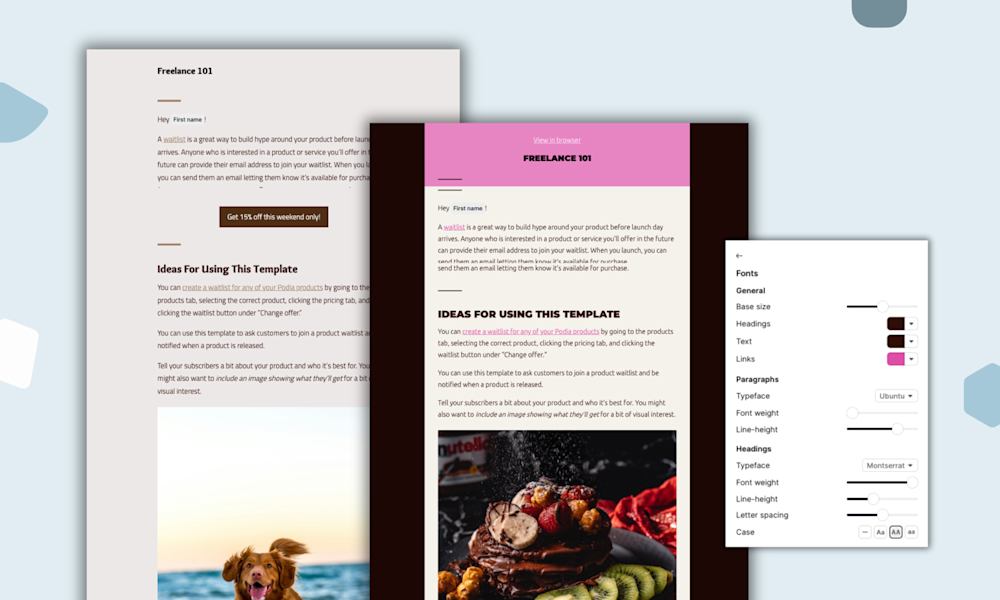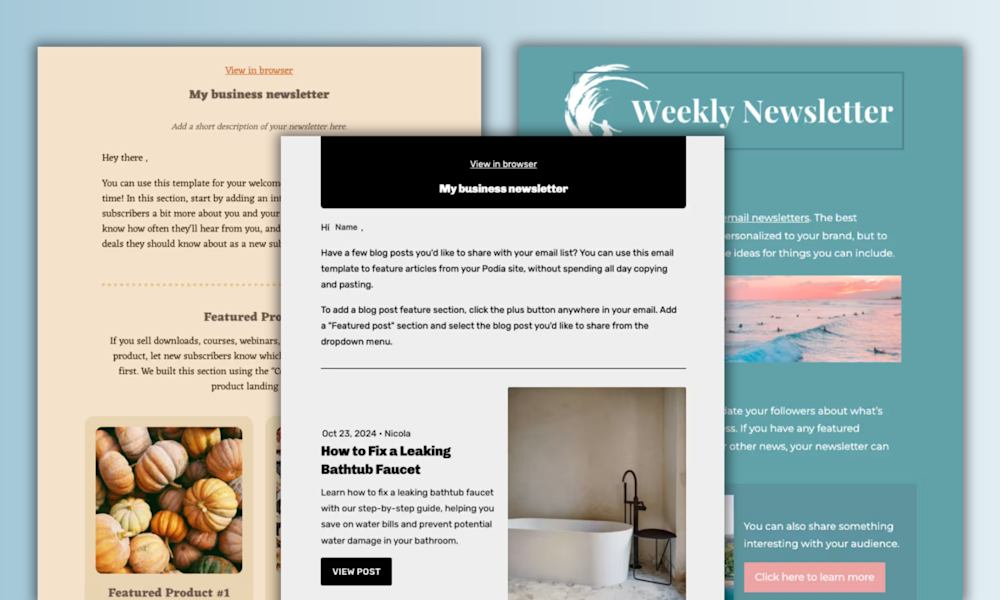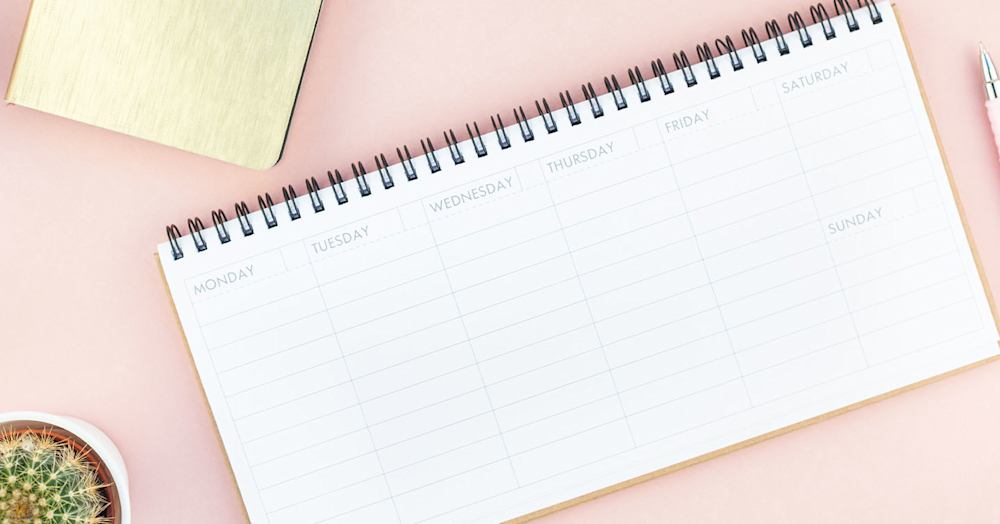You’ve done everything right. You’ve made a signup form so people can join your email list, and you’ve even designed a unique lead magnet. It took some work, and now your email list is growing.
You know it’s time to send your new followers a newsletter. That’s the whole point of building a list, right?
But you’re stuck. The thought of sitting down and creating email newsletters makes you break out in a cold sweat.
It’s tempting to procrastinate for eternity, but it doesn’t have to be that way. By following a few tried and true email newsletter best practices, you’ll be sending awesome emails to your biggest fans in no time.
In this post, we’ll break down exactly how to create an email newsletter that’s consistent, relatable, valuable, and adored by your audience.
Why create an email newsletter?
Email newsletters are mass messages you send to your followers. Many creators choose to send weekly or monthly newsletters to stay in touch with their audience.
Having an email newsletter can be a great way to drive sales, increase website traffic, and build community.

A good rule of thumb is that if you plan to consistently communicate with your audience, you should have an email newsletter.
#1. Emails are direct
Email may not be flashy, but it makes up for that by offering a direct and personal line of communication with subscribers.
When you open an email, the message fills the majority of your screen. It grabs your attention, even if just for a few moments.
As a creator, this means that you can talk to your subscribers one-on-one without worrying about character counts or distracting ads. Plus, this closer connection can build trust.
People are more likely to buy from brands they know and trust, so it’s no wonder 81% of small and medium businesses use email marketing to acquire new customers.
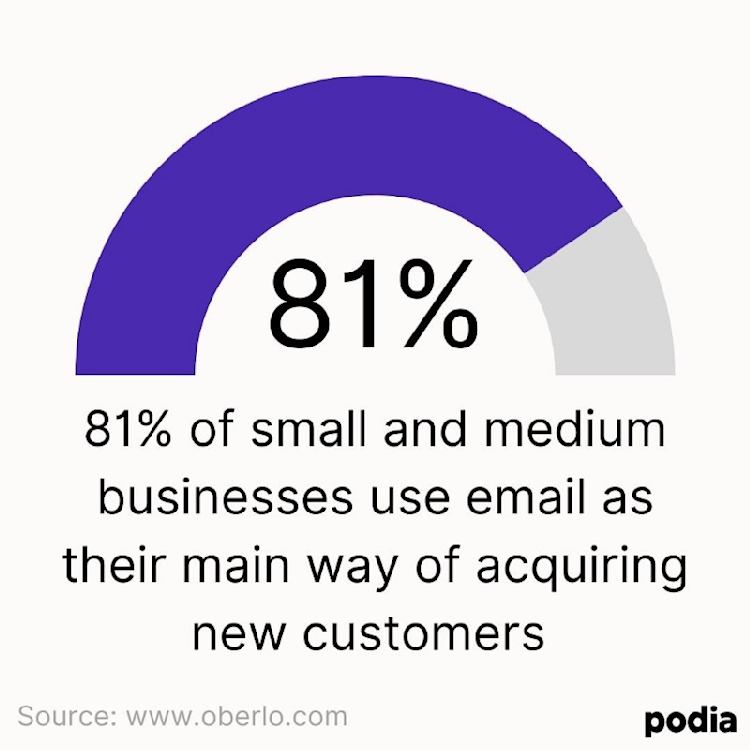
Whether you’re selling online courses, ecommerce products, digital downloads, or coaching, an email newsletter can be an ideal place to nurture potential clients.
#2. Inboxes are more reliable than social media
Social media platforms are great for building brand awareness and sharing your work, but it’s risky to use them as your only point of contact with your audience.
At the end of the day, access to your hard-earned fans is in the hands of the platform.
With wacky algorithms, accidental account deactivations, and more networks adopting a “pay to play” model, it makes sense 64% of small businesses turn to email marketing to communicate with customers.
#3. Email is low cost
The nice thing about email marketing is that it’s inexpensive to get started. Even if you’re on a modest budget, it’s possible to start building your email list and sending newsletters with minimal upfront fees.
Many email marketing platforms, such as Mailchimp and ConvertKit, offer free plans if you have less than 1,000 subscribers, making this a low-risk, high-reward investment.
For Podia users, robust email marketing features are included with all plans at no additional cost.
You can even try Podia free for 30 days to give email marketing a try without spending a penny.
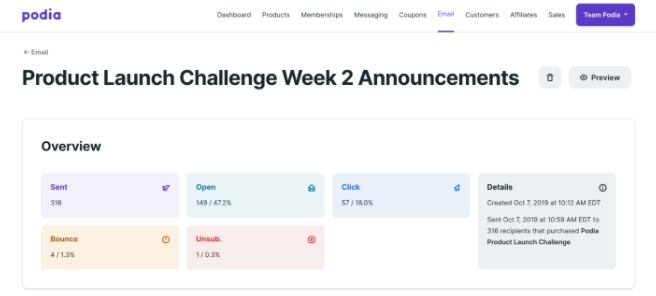
A regular newsletter can be a powerful part of your email marketing strategy. Let’s take a look at some things you can include in your messages.
What are the elements of an email newsletter?
The elements you choose to include in your email newsletter will depend on your brand personality and objectives.
Some creators use newsletters to announce new products, courses, and services. Others use this tool to share information about a particular topic, like new blog posts, studies, and industry news.
Here are some things you can include in an email newsletter:
-
A round-up of new content
-
Updates on product releases
-
A look at what’s going on in your business behind the scenes
-
Introduce upcoming events, email campaigns, or webinars you’re hosting
-
Industry-related news
-
Relevant blog posts that you found interesting
-
Testimonials from happy clients
-
Tips and advice related to your niche
-
Inspirational case studies and stories
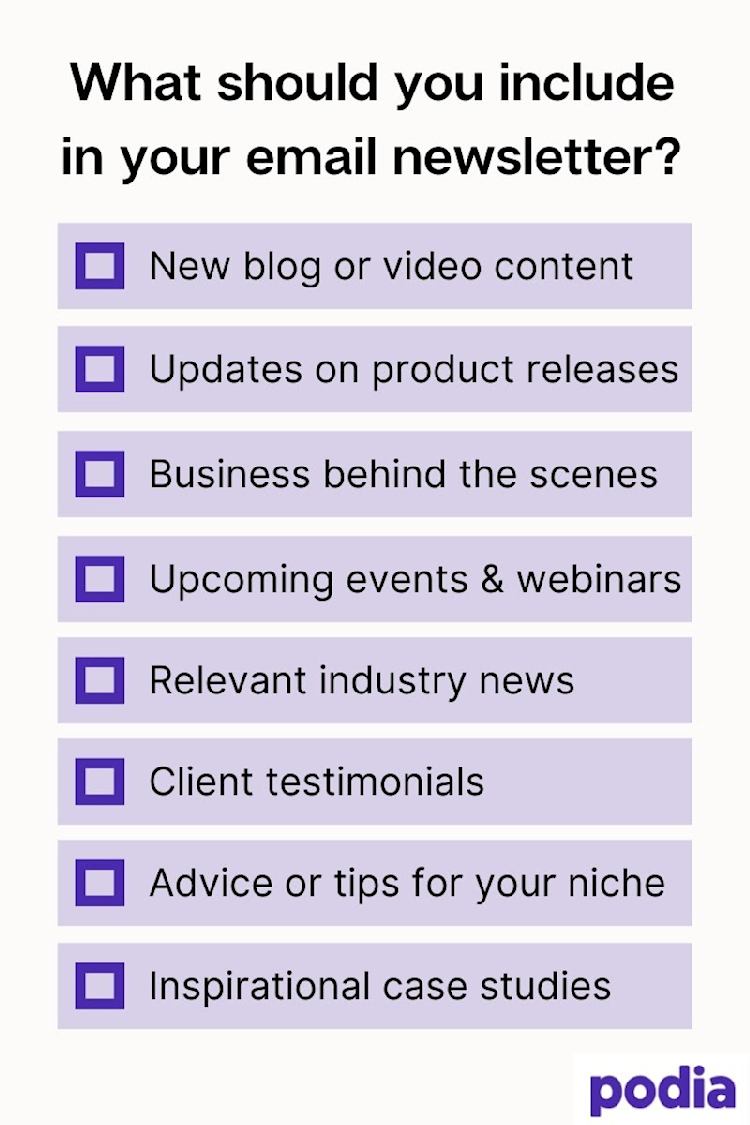
Now that you know what makes a good newsletter, we’ll explore how to create the best email newsletter for your audience.
9 email marketing best practices
1. Personalization
Email newsletters are most effective when they’re personalized for your specific audience.
82% of marketers reported that they saw higher open rates for personalized emails compared to generic messages.
Using your subscriber’s name in the email greeting is a good start, but we can go more in-depth by using segmentation.

First, let’s look at personalization.
While it can be tempting to cast a wide net and get as many followers as possible, it’s more efficient to catch the right followers who are interested in your specific niche. These people are your target audience.
If you use a free lead magnet, make sure it’s relevant to what you’ll be discussing in your newsletter and the products you offer.
For example, if your business is all about vegan baking, a free lead magnet about gardening won’t draw the right audience.
You might get droves of followers, but there’s no point filling your list with people who aren’t interested in your primary offerings (i.e., your incredible vegan cookies).
A better fit for your lead magnet would be a vegan recipe card or baking tutorial video.
If you use a “Subscribe to my newsletter” (a.k.a. email capture) box or popup, let people know exactly what they’ll get when they join.
Being upfront about how often you’ll communicate and what you’ll talk about helps set expectations and build trust.
For example, “Subscribe for weekly recipes from my vegan kitchen” is much clearer than “Subscribe to my newsletter”.
This email capture form from This Week in Blogging is a great example. It clearly states what the newsletter is about and how often it will be sent so subscribers know what they’re signing up for.
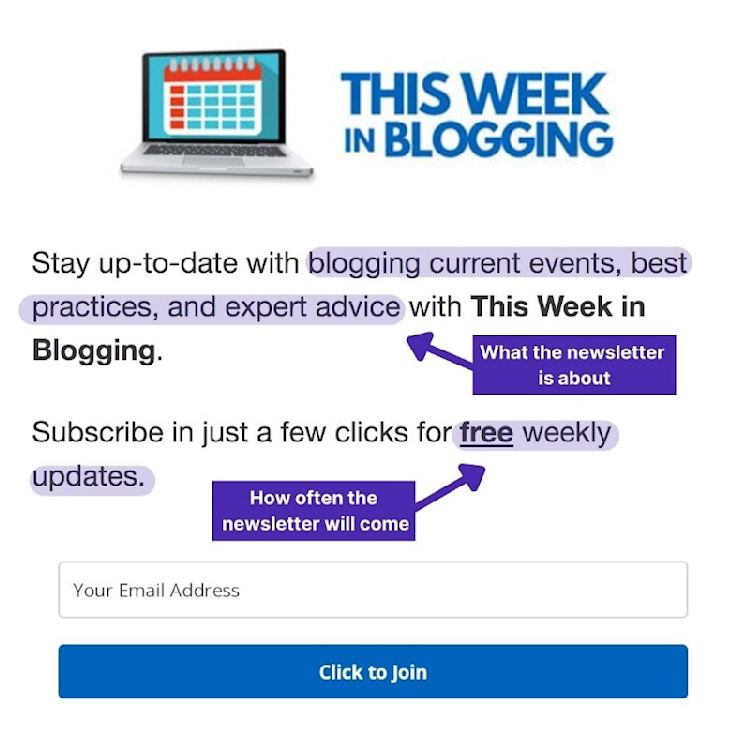
Now that you’re attracting the right audience, let’s look at segmentation, a tactic favored by 51% of email marketers.
Segmentation means sorting your followers based on their interests. Then, you can customize the emails you send to each group of people so everyone receives content they enjoy.
Let’s revisit your vegan baking business. Imagine you’ve got a list of newsletter subscribers who are in love with your delicious recipes.
But now you’re creating a new online course about how to self-publish your first cookbook.
There’s a good chance your fans who love your vegan apple pie won’t be interested in cookbook publishing, and we don’t want to bombard them with content that’s not relevant.
This is where segmentation comes in.
Instead of sending one big email to all of your followers, divide your list into people who love recipes and people who want to learn more about self-publishing a cookbook.
That way, you can send out specialized newsletters to the two groups of people interested in each topic.
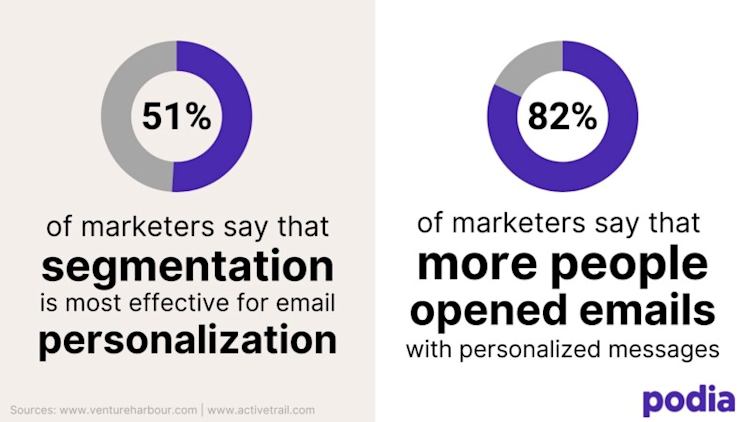
Even though it’s a bit more work, these thoughtful touches pay off.
Using email personalization and segmentation can result in 46% higher open rates than one-size-fits-all emails.
Basically, you’ll get the most mileage out of your newsletter if you attract the right audience from the start and send them personalized, segmented messages.
2. Include a welcome email
A welcome email is an automated message that is sent immediately after someone subscribes to your newsletter.
This welcome message is email gold. Over 90% of people open welcome emails, and they have a click-through rate of nearly ~27%.
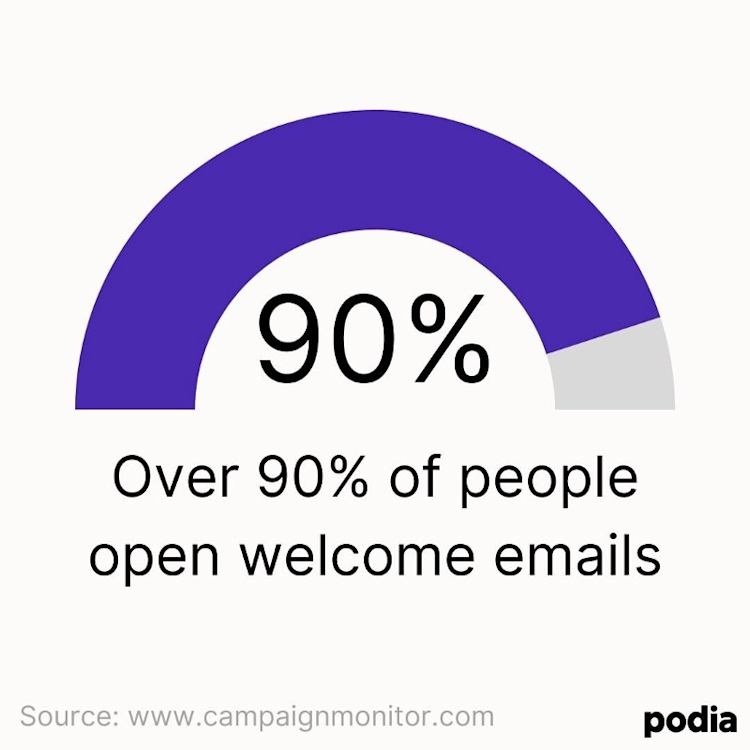
That’s a huge opportunity to meet your new subscribers and welcome them into your online world.
Thank them for signing up, tell them what they can expect from your brand and your newsletter, and make them feel valued from day one.
Take a look at the welcome email creator Stacey Myers sends to new subscribers.
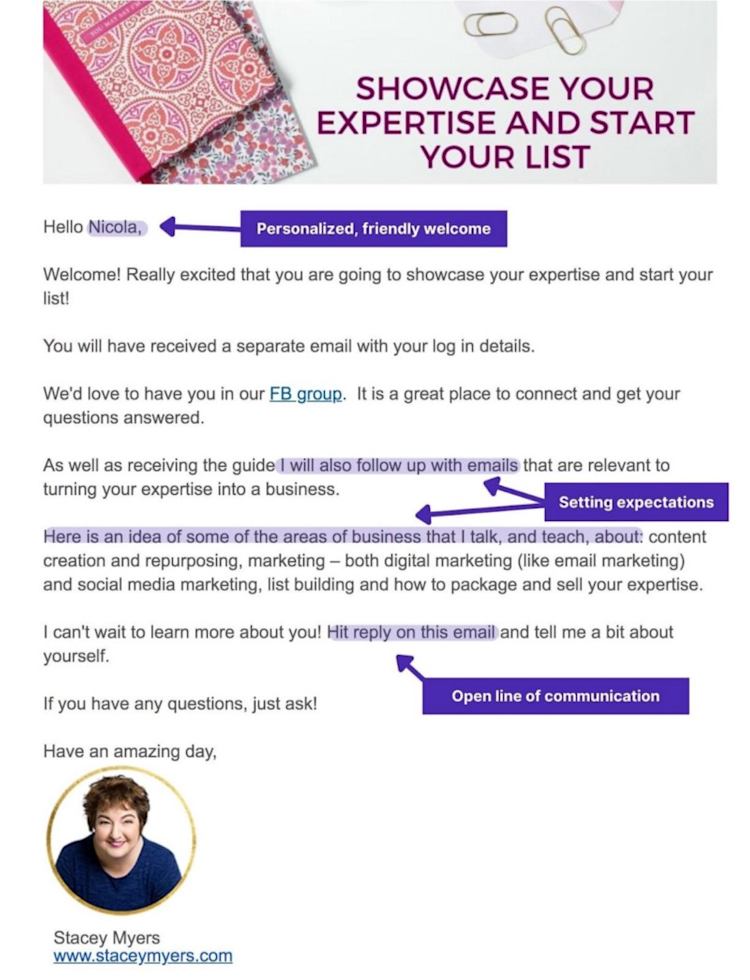
The message starts out with a warm, personalized welcome. Then, Stacey lets readers know that she’ll send follow-up emails about how to turn your expertise into a business.
She also includes links to a Facebook group where new members can get their questions answered and connect with other followers.
Finally, the email closes by encouraging subscribers to respond and say hello, which opens the line of communication.
The result is a welcome email that makes new subscribers feel excited about joining and supported as they take their next steps.
3. Share your personality and add value
People join your email newsletter because they already love what you’re doing. The average person receives well over 100 emails per day, and your subscribers said that they like you so much they want to hear from you too.
You can definitely use your email newsletter to promote your products, posts, and online courses, but you can also use it to connect with readers on a personal level.
This email from Airtable is a perfect example of a message that’s friendly, relevant, and fun. It makes me feel like I know the sender, and I can certainly relate to their enthusiasm for Kit Kats.
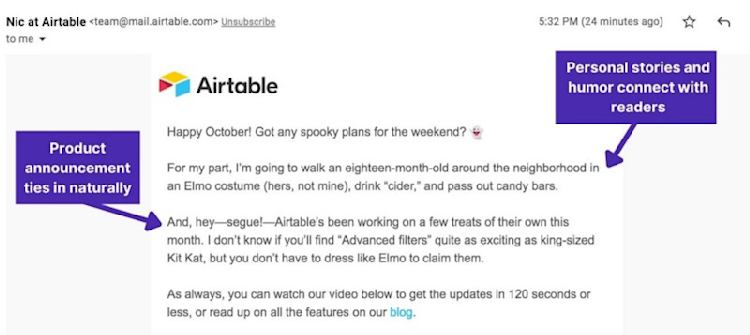
Basically, whether it’s stories from your life or an authentic look behind the curtain of your business, getting more personal with your newsletter can foster closeness and familiarity.
In addition to showcasing your personality, every email you send should offer value to your readers. This could be a helpful tip, an informative blog post, a tutorial video, an entertaining piece of content, an interesting case study, or words of encouragement.
Then, when you have a new product or service to sell, you won’t be a random salesperson in your readers’ inboxes: you’ll be a trusted friend with a reputation for providing value.
4. Stick to one goal per email
Effective emails should only have one main call-to-action (CTA) or task you want your readers to do.
This can be buying a product, reading a blog post, watching a new YouTube video, or any other next step, but the important thing is sticking to one.
If you tell me to go to the grocery store to buy butter, milk, eggs, toothpaste, and a candy bar, there’s a chance I’ll forget something from that list.
But if you only tell me to buy a candy bar, you’re much more likely to receive your delicious chocolate treat.
The same is true for your emails.
If you tell your reader to check out ten products, and read your new blog post, and sign up for a free webinar, and watch this cute cat video, they’ll probably feel overwhelmed and click away.
This email from Grammarly is a great example of why having one objective is impactful. By looking at this email, I know exactly what to do to claim this deal.
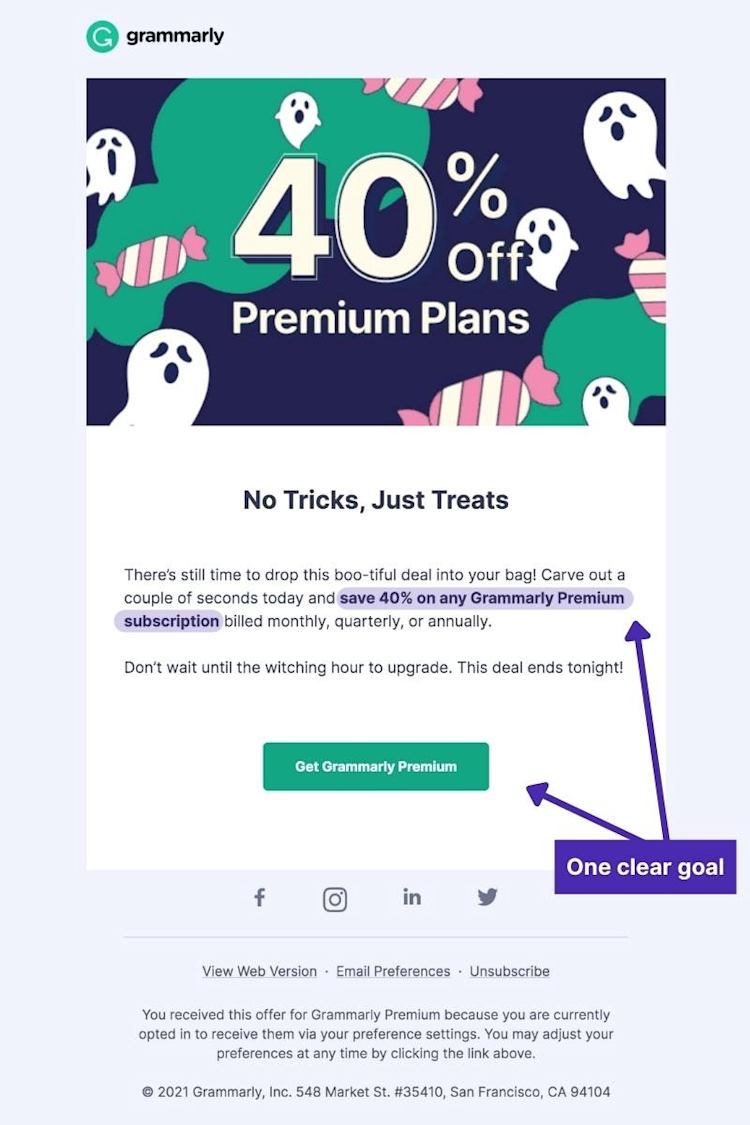
You don’t want your objective to get lost in the shuffle, so stick to one main goal per email.
5. Use a strong subject line
Subject lines are the shortest part of your email and often the most important: 47% of email recipients will open a message based on the subject line alone.
Wondering how to write click-worthy email subject lines? I’m glad you asked.
Keep it short. 82% of marketers use shorter subject lines that are 60 characters or less. Email clients (i.e., Gmail or Outlook) might shorten your subject line if it’s too long.
Pique their interest. Asking a question, sharing an interesting statistic, or announcing an exclusive offer can stir curiosity and result in more clicks.
Create a sense of urgency. Urgency encourages your readers to take quick action and open your email so they don’t miss out.
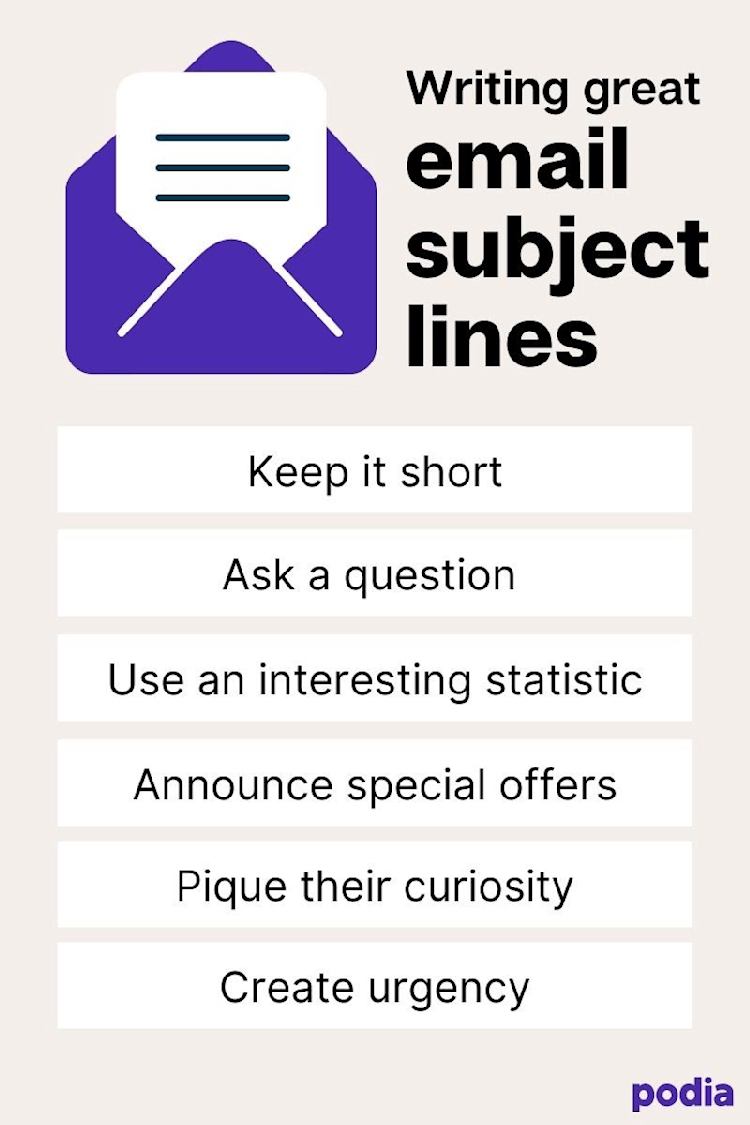
If you want to see examples of subject lines in the wild, you can dig into our Podia newsletter by subscribing below.
6. Pay attention to your email newsletter design
Remember the last time you visited a website that looked outdated? Chances are you didn’t stick around long and definitely didn’t make any purchases.
The same can happen with emails. If your emails look cluttered and unappealing, your readers might click the delete button before they get to know your awesome business.
We don’t want that to happen.
To give your emails a leg up, they should look clean, modern, and aligned to your brand. Here are some top-level tips:
-
Include your brand logo or a related header image at the top of the email for quick recognition.
-
Use headings and subheadings within the body of your email to break up walls of text.
-
Use your brand colors for buttons and accents.
-
If your email provider offers newsletter templates, make sure to choose one email template and stick with it for continuity.
-
Images, videos, emoji, and gifs can add interesting visual elements, but use them thoughtfully because multiple large files can impact email deliverability.
-
The footer is your friend. Use this space to add links to your social channels, popular products, and upcoming programs.
-
Remember to always include an unsubscribe link.
This newsletter from Lia and Jeremy, the travel bloggers behind Practical Wanderlust, is a great example of email design best practices.
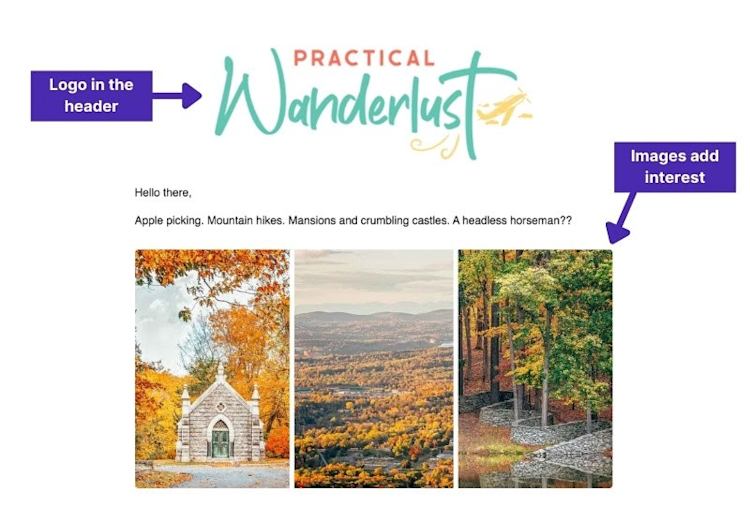
Their message starts with a bright logo in the header and a catchy introductory line that gets my attention. Then they include three high-quality images that are relevant to the email content.

The email continues with a short paragraph about the new piece of content they’re promoting, followed by an eye-catching CTA button.
In the footer, there are links to their social media channels and podcast, as well as an affiliate disclosure, account management links, and an unsubscribe option.
They’ve used their brand colors and fonts throughout the email so it feels cohesive. All these elements work together to make their newsletter easy and enjoyable to read.
7. Proofread and send a test email
Once your email newsletter is ready to go, give it a full read-through to make sure it is error-free. I like to use Grammarly and Hemingway for additional proofreading.
Before launching your newsletter, you should always send a test email to make sure your message is showing up as expected.
To do this in Podia, push the “Send test” button next to your email draft.
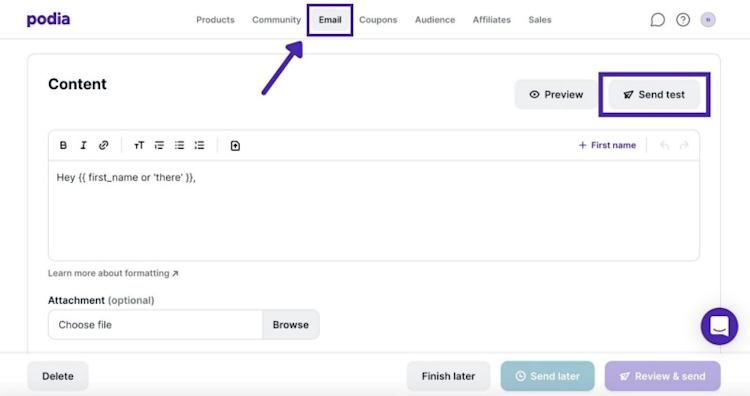
Then you can check it in several different browser windows and see how the email shows up on your phone.
81% of people check email on their smartphones, so you definitely want to make sure your email looks good on your mobile device before sending it out into the world.
I can’t tell you how many times I rushed to hit send without checking my formatting, only to discover I’d sent a mass email with chopped-in-half images or text so large it looked vertical on mobile.
A test email allows you to fix any layout issues before going live. Take it from me: It’s a game-changer.
8. Consistency
Sending newsletters on a consistent schedule shows your audience when they can expect to hear from you.
This can help you stay accountable and build a routine between you and your followers.
According to CampaignMonitor, it’s best to send at least one email per month but no more than two emails per week.
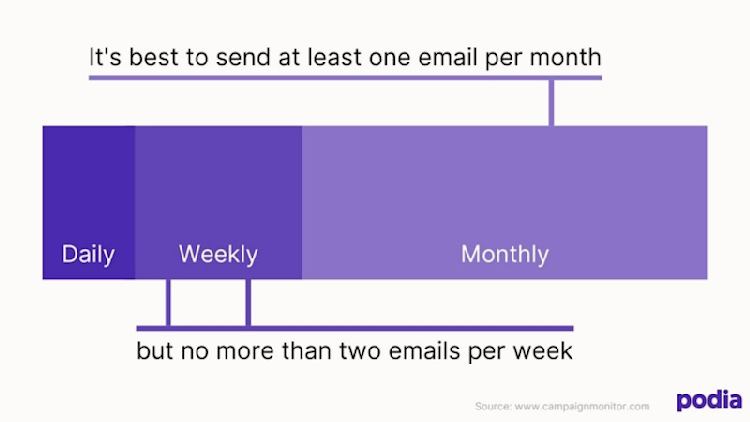
There are countless studies about the best days and times to press send, but truthfully, I’d recommend good, old-fashioned trial and error.
Sending an email at 9:00 a.m. every Tuesday might be perfect for some businesses, but every audience is unique.
The only way to see what works best for your following is to experiment with different sending schedules and see how your subscribers respond. We’ll talk about how to do this more in the next section.
For now, the most important thing is simply to start. You’ll have plenty of opportunities to refine your schedule as time goes on.
Pick a time, commit to sending your newsletter, and keep with it. It’s that simple.
9. Test and track your email newsletter data
Now that you’re sending consistent newsletters, it’s smart to experiment with days, times, and subject lines.
You can do this by changing elements of your message and tracking how your audience reacts.
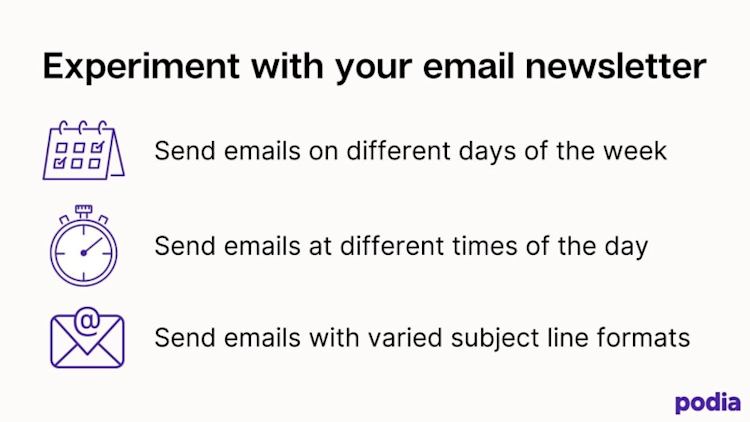
For example, try sending emails on different days of the week to see which days have the highest open rates.
Once you’ve identified a day that works well for your audience, send newsletters at different times throughout the day to see when your audience is most likely to click.
Then, you can send some emails with emoji in the subject line and some without to see if that impacts your open rate.
Over time, you can continue to tweak the types of emails you send to see what resonates most with your subscribers.
Most email service providers will give you analytics for each email blast you send, allowing you to track open rates, click-through rates, and other juicy details.
At Podia, you can check these statistics by clicking on “Email” in the top menu. This will give you a high-level look at how all of your broadcasts have performed.
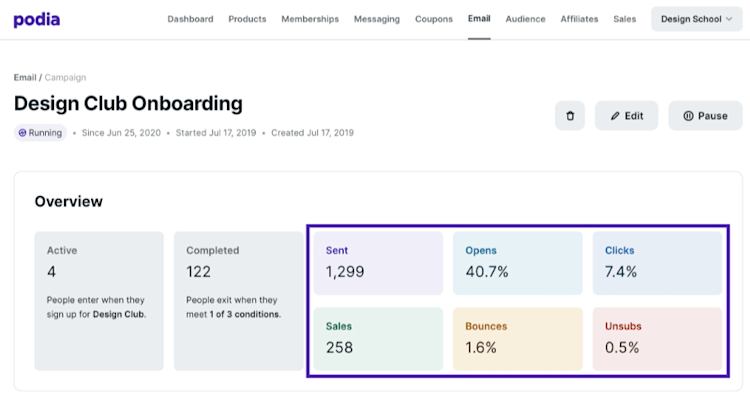
Here’s what each statistic means:
-
Sent: The total number of people that were sent your broadcast
-
Opens: How many people opened your email
-
Click: How many people clicked a link within your email
-
Sales: How many sales were made from your email
-
Bounce: The number of emails that “bounced” or failed to send
-
Unsubscribe: The number of followers who unsubscribed from your list
If you click on an email, you’ll get a more in-depth look at these metrics, including specific actions each subscriber took.
This data can help you see what’s working and what needs adjusting in your email newsletter strategy.
Successful email newsletter example
To show you how this all looks in practice, let’s check out a successful email newsletter example from Leanne at Passive Income Superstars.
These are elements you might want to include in your own newsletter. Take a look at how they can all work together.
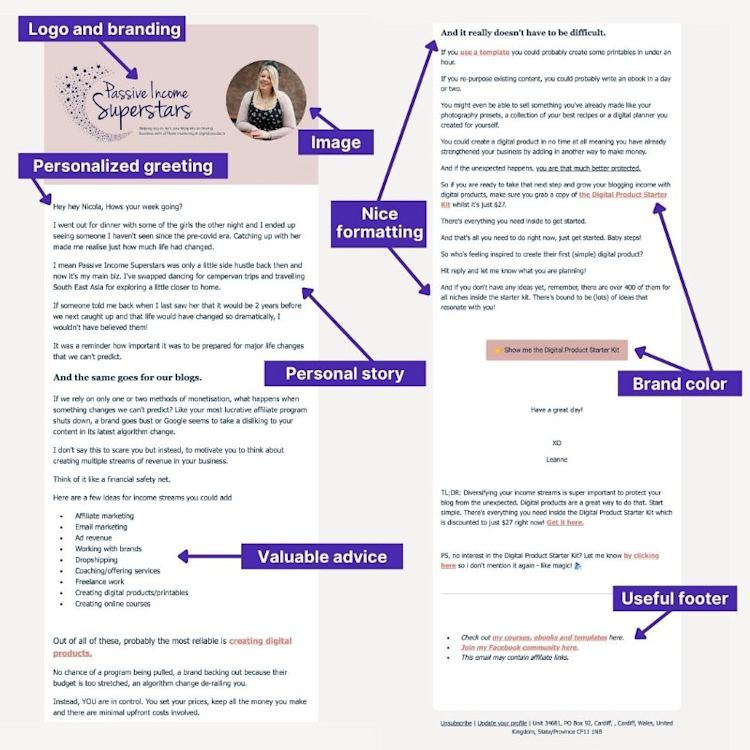
-
Logo and branding: Right from the start, I know who sent this newsletter. Including a logo enhances brand recognition.
-
Image: The author’s image builds familiarity.
-
Personalized greeting: Most email newsletter tools allow you to address your readers by name if you collect this information from them when they subscribe.
-
Relevant content: The email opens with a personal story. Then, it offers valuable tips and advice related to the interests of the subscriber.
-
Email formatting: This message uses headings, short paragraphs, lists, emoji, and brand colors. There’s enough white space that it doesn’t look cluttered, and these elements break up the content so it’s eye-catching and easy to read.
-
Footer: The footer includes a link to the creator’s social media account and other digital products. There’s also an unsubscribe link at the bottom of the page.
Ready to start creating your own email newsletter like this? I’ll show you how in Podia.
How to create an email newsletter in Podia
To create your first email newsletter in Podia, start by clicking the “Email” tab in your dashboard.
On the right-hand side of the screen, click the button that says “Create,” then select “New broadcast”.
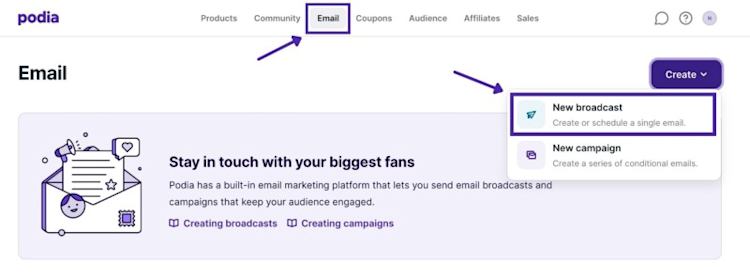
Next, you’ll be prompted to add a subject line and choose your recipients. You can send your message to a particular segment or to all of your email subscribers.
Continue to scroll down, and you’ll see the place to add your newsletter content. In the Podia editor, you can easily add lists, headings, images, PDF files, and more.
When you’re finished, you can send the message right away or schedule it to go out at a later time.
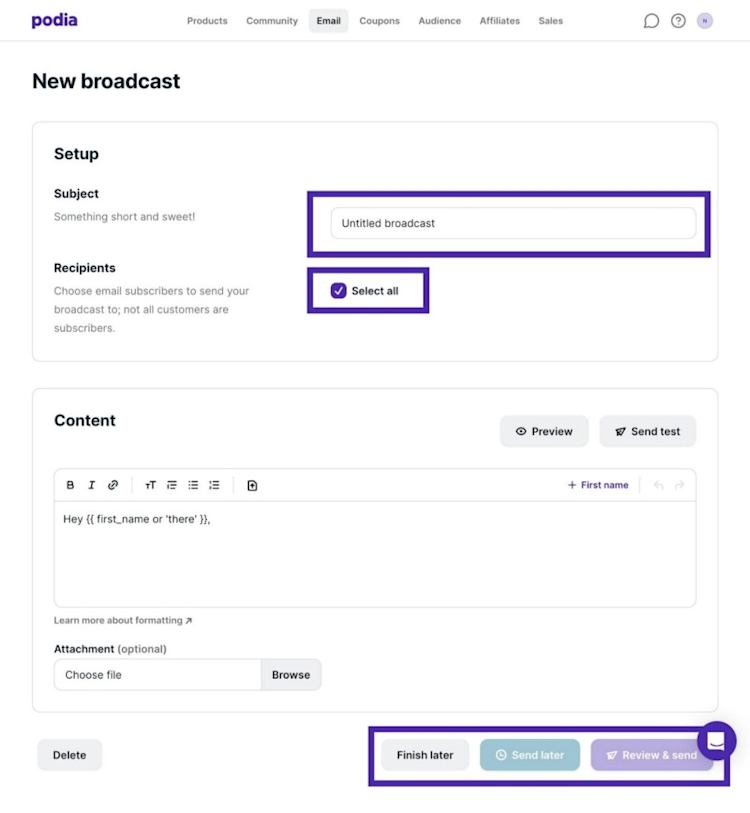
And that’s all there is to it. I can’t wait to see what kind of newsletters you send.
Start sending better email newsletters today
Creating an email newsletter your audience loves can be a rewarding way to connect with your readers, make more sales, and build trust.
To design the ideal strategy for your business, use the following email marketing newsletter best practices:
-
Email newsletters should be personalized. Create opt-ins that attract your ideal followers and segment your list if you discuss a variety of topics.
-
When someone new signs up, they should receive a welcome email.
-
Your newsletter should showcase your personality and provide value to your reader.
-
All messages should have a short but strong subject line.
-
Newsletters should be well designed, uncluttered, and easy to navigate.
-
Follow a consistent schedule when sending newsletters.
-
Try sending emails at different times and with different subject lines to see what variations work best for your audience.
With just a few clicks, you’ll be on your way to more conversions and deeper connections through your awesome email newsletter. Best of luck!
